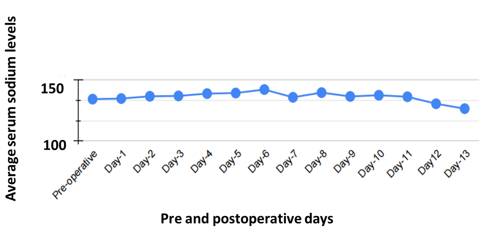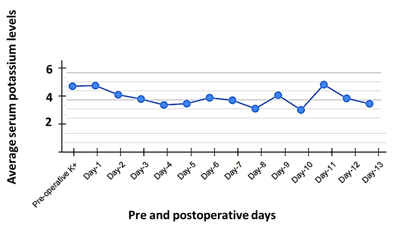Introduction
Fluid balance regulation, tissue excitability and acid base equilibrium, cellular function and its survival and other manifestationsare associated with presence of inorganic electrolytes in our body. These inorganic electrolytes like sodium, potassium, chloride and calcium are very important constituents of the body.1 There are preoperative, intraoperative and postoperative changes in both fluid volume and electrolyte compositions.2 Any operative trauma leads to series of changes which is referred to as a metabolic response to injury. Magnitude and duration of this response is directly proportional to the severity of the trauma.3, 4 Operative trauma affect the physiology of fluid and electrolytes within the body. Moore’s metabolic care of the surgical patients is a milestone in the field of modern surgery.5 Due to surgical intervention the normal physiology gets distorted. This decides the successful post-operative result. Surgical care is based on an understanding of the normal adaptation and to treat it when abnormal.6, 7 Fluid and electrolyte management has thus been an integral part of care of each and every surgical patient.8
Plasma sodium concentrations disorders are very common in the patients who are hospitalised for a long duration of time. Patients who undergo major surgeries are more prone. In peri-operative period there will be major stress response and fluid loss will occur. The previous studies have showed hospital outcomes associated with dysnatraemias.9, 10 There are small changes like measurement artefact or diurnal variations and large changes usually associated with iatrogenic factors or endocrine response. These can induce osmotic dis-equilibrium and cerebral dysfunction.
Table 1
Type of surgery and demographic details
Table 2
Observation of changes in serum sodium and potassium levelin post-operative period
Materials and Methods
The study was conducted in intensive care unit (ICU) of tertiary care hospital, Loni, Maharashtra, India. The cases were selected among the patients operated in the same hospital and then getting admitted to ICU from 1st of November 2020 to 30th April 2021.The written, verbal and informed consent of patients or his/her relative was taken. The patients including males and females of age more than 18 years undergoing elective or emergency surgery getting admitted in rural critical care unit were included in the study. The latest preoperative serum sodium and potassium levels were recorded. The postoperative serum sodium and potassium levels along with postoperative day were noted till the patient wasin ICU. The diagnosis, type and duration of the surgery had been noted from the records.
Results
This study involves the post-operative patients admitted in rural critical care unit from November 2020 to April 2021. Total 111 cases were studied out of which 101 were major surgeries including 72 males and 29 females and 10 were minor surgeries including 2 males and 8 females. These groups were further divided on the basis of age group less than 60 years and more than 60 years as shown in Table 1. The trend of postoperative average serum sodium and potassium is depicted in Table 2.
Discussion
In the present study, the average preoperative level of serum sodium was 134.26 meq/L and serum potassium was 4.05 meq/L as shown in Table 2. Preoperative serum electrolyte levels of both serum sodium and potassium levels were within normal limits. In the present study we observed, there was gradual rise in the serum sodium level till post-operative day — 6 and then it started decreasing and attained its normal preoperative value on post-operative day-11. The preoperative sodium level was restored in all cases by the 11th postoperative day as shown in the Figure 1.
There was a gradual fall in serum potassium level from post-operative day-1 to post-operative day-6 and then it started increasing and attained pre-operative value by post-operative day-11 as shown in Figure 2. So, the response of serum potassium and serum potassium is contrary to each other as studied previously. 11, 12
The hormonal response to surgery leads to release of catecholamines which stimulate hypothalamo- pituitary- adrenal axis and increase in cortisol, aldosterone and ADH. These cause oliguria and retention of sodium and chloride and increase urinary excretion of potassium. This whole mechanism can be explained as production of extensive inflammatory exudates around traumatized tissue. These exudates are rich in water, sodium, chloride and protein all of which necessary for healing process. Therefore, water, sodium and chloride retention occur. Breakdown of protoplasm of injured tissue (especially skeletal muscle) lead to Potassium release, thus causing slight rise of serum potassium, as it is being produced in such a great quantity that it may not be excreted by kidney with sufficient speed. 13, 14, 15 This explains Potassium paradox i.e. increased plasma level despite negative metabolic balance. In our study we did observe there is an increase in serum potassium levels postoperatively for initial two days and gradually reached to normal values by postoperative day 6 to 7.
Limitation of the study
The study was done on limited number of samples (111). We recommend conducting such study in large number of patients. We have not taken into consideration of intravenous fluid administered in perioperative period and not studied other electrolytes.
Conclusions
Based on the study results, the sodium levels were seen in increasing trend in the post-surgical patients as compared to the preoperative levels. The potassium levels were of decreasing trend in postoperative levels. Normalization of these serum sodium and potassium levels are seen postoperative day seven onwards. One should carefully monitor the electrolytes postoperatively and treat accordingly. The type of fluid selection in postoperative period is an important aspect to avoid life threatening complications related to electrolyte imbalances.


